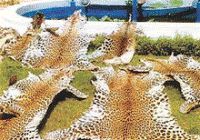Indian traders hand over truckloads of rare animal skins and fur garments
Traders in the Indian portion of Kashmir handed over truckloads of rare animal skins and fur garments worth millions of dollars.

The skins belonged to tigers, leopards, snow leopards, black panthers, clouded leopards, brown bears, lynx and wolves. These animals are protected under the Indian Wildlife Act and their killing is punishable by up to six years imprisonment.
Authorities had taken an inventory of the stocks in 1997, but left skins and garments with the traders, promising to collect them after they had decided on compensation as part of a deal.
But nothing happened for a decade.
"We have suffered for 10 years. We couldn't sell our stocks because of the ban and there was no compensation paid by the government" in the meantime, said Ghulam Ahmed Dar, a trader.
On Monday, four traders came with their stocks to the Dachigam wildlife sanctuary, a collection point nearly 20 kilometers (12 miles) east of Srinagar, the summer capital of India's Jammu-Kashmir state.
The process began over the weekend and is likely to continue for 1 1/2 months, said Mir M. Mansoor, the chief biologist at Wildlife Department.
One of the traders possessed 70 snow leopard skins and 12 tiger skins. Traders are expected to hand over more than 800,000 skins and fur garments to the officials, Mansoor said.
Hundreds of thousands of 30 protected species have been slaughtered in India, Nepal, China's Tibet and Sri Lanka, said Rashid Naqash, another wildlife department official.
India's Jammu-Kashmir government imposed the ban in 1997 and asked 224 registered traders to surrender their stocks in return for compensation.
The Wildlife Department had made inventory of the stocks, but the state government took 10 years to approve 94 million rupees (US$2.3 million) in compensation.
Mansoor also said the government was working on the traders' rehabilitation.
Kashmiris have been trading in fur for centuries. With some of the best artisans available in the Indian portion of Kashmir, Srinagar became a preferred destination for the animal skin trade in South Asia.
The Wildlife Department says at least 20,000 people were involved in the fur trade in 1997.
It became so lucrative that several shopping districts in Srinagar The Bund, Boulevard and Polo View became popular for animal skins and fur garments.
"Our products mainly had demand in (the former) Soviet Union and Japan," said Ghulam Rasool, a trader.
Subscribe to Pravda.Ru Telegram channel, Facebook, RSS!


